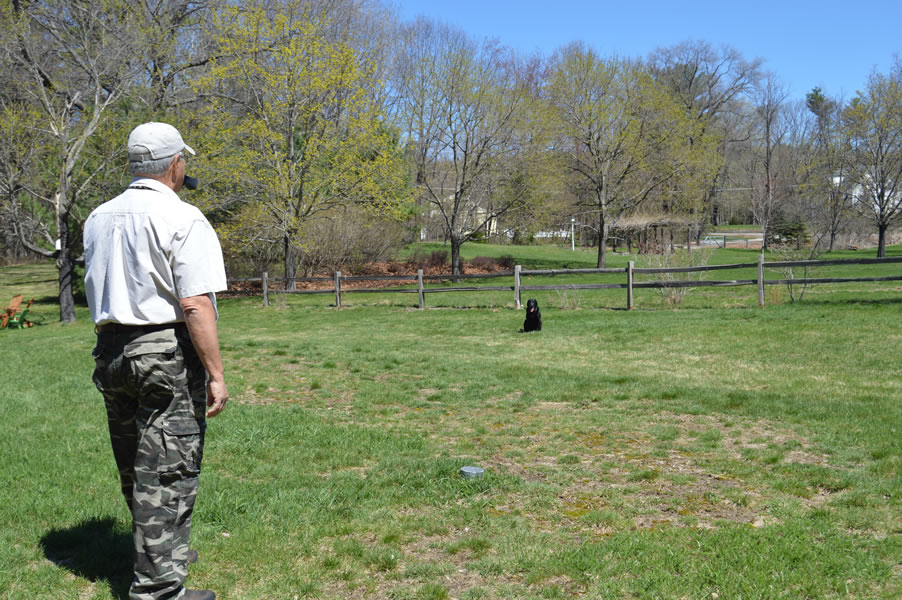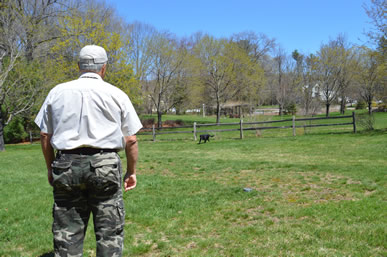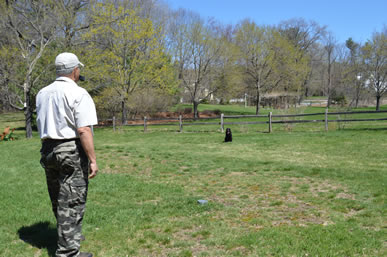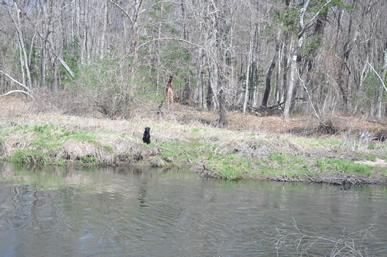
Now that your dog understands one whistle blast means sit, let him off lead and encourage him to walk around. Let him create some space between the two of you but not too far to start. As he is just snooping, blow one whistle blast, command sit, and immediately blow another single whistle blast. When he sits, keep him sitting for a few seconds. Often, the first blast at a distance only gets the dogs attention but that’s OK – at least he‘s looking at you.

Off lead, let your dog walk around unrestricted so he creates some distance between him and you but only 1o feet away to start. When he sits appropriately to the whistle at that short distance, you can let him extend.

At random times as he gets farther away from you blow one whistle blast, command sit, and immediately blow another single whistle blast. When he sits, repeat the verbal sit command as necessary to keep him sitting for a few seconds. Then release him and praise the heck out him.
Know that one whistle blast, especially at longer distances, will not make him immediately sit every time but it should at least get his attention. Once you have his attention, and most likely he is just standing, begin the sequence.
He CANNOT start moving around on his own. You do NOT want the dog TO COME TO YOU on these commands. With this skill, the dog must stop, look at you, sit and remain sitting while looking at you for your eventual hand signal (BUT YOU ARE NOT GIVING HIM HAND SIGNALS AT THIS POINT – THAT COMES LATER.) If you need to blow the whistle a second time to make him sit, do it. If you have to keep blowing the whistle, he is most likely confused.
If the dog gets confused STOP THE DRILL. Come back tomorrow and try again. With patience on your part the dog will eventually get the idea. When he does, gradually create more distance and keep working at it. The first few times you do this drill, when he gets it perfectly right even if only 10-20 yards from you, quit the drill. He did what you wanted. Let him feel good about that success. Do not overdue this drill and do not try to rush the dog along. Like with most drills, it matters not how long he takes to learn the skill – it matters how well he learns the skill. Be patient. It’s worth it. Actually, it’s necessary.
An advantage to teaching sit to the whistle at a distance in this way is then you can do it randomly when the dog doesn’t realize he is being trained. When you’re just out in the yard or taking a causal walk in a field, blow the sit whistle to make him sit. Don’t do it every five minutes, just once in a while.
But if you do that, even in a ‘casual’ setting, you have to make him sit. If you need to add the voice command sequence, do it. Remember, never give your dog a command that you are not in position to enforce.
Obviously, while swimming in water, the dog can’t sit to the whistle so the goal is to make him stop swimming, turn to you and tread water so he can take a hand signal. Do NOT work this in water until he is proficient at it on land AND not until he has learned to take hand signals otherwise you will be making him stop and tread water with no end game.

Eventually your dog must sit to the whistle while across water. Wait to do that until he is proficient at the sit to the whistle on land – and DO NOT start giving him hand signals until you earnestly begin those handling drills.

Later in his training, when he understands hand signals, you can begin to handle him across water at short distance to start.
Add distance to sit to the whistle like your hunting depends on it.